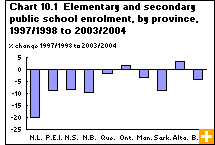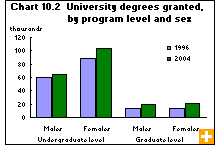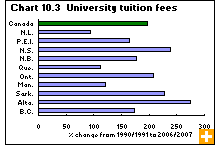Common menu bar links
Education, training and learning
Archived Content
Information identified as archived is provided for reference, research or recordkeeping purposes. It is not subject to the Government of Canada Web Standards and has not been altered or updated since it was archived. Please contact us to request a format other than those available.
For the past 20 years, the proportion of students who graduate from high school has continued to grow. In addition, an increasing number of young people go on to postsecondary education, and girls are now more likely than boys to do undergraduate university studies full-time. At the graduate level, university enrolment among women was also almost equal to that among men.
The school-age population should decline in the coming year because of the drop in the birth rate. This decline could, in some areas, result in underutilized facilities, overstaffing and fewer program offerings. Conversely, areas where enrolment has been rising may feel pressure to spend more to maintain per-student expenditure.
The increasing cultural diversity of Canada’s school-age population can also have repercussions on the school system. For example, some provinces have school boards or commissions that reflect religious and language preferences. Moreover, students who have difficulty in the language of instruction, be it English or French, usually take additional language training.
Student population
The number of students enrolled in public elementary and secondary schools in Canada has slipped compared with the 1997/1998 school year. Nearly 5.3 million children were enrolled in public schools in 2003/2004, down 1.2% from 1997/1998.
During this period, enrolment in public elementary and secondary schools, measured in full-time equivalents, rose only in Ontario and Alberta. In Ontario, enrolment reached 2.1 million students in 2003/2004, up 1.6% from 1997/1998, while in Alberta, enrolment rose to 549,500 students, a 3.2% increase. In Ontario, the increase is essentially the result of immigration; in Alberta, it is the result of migration from other provinces.
The biggest drop was in Newfoundland and Labrador, where enrolment has fallen 19.9% since 1997/1998 to 81,545 in 2003/2004. Net migratory loss to the other provinces largely explains this situation.
The number of students enrolled in Canadian universities reached the 1 million mark for the first time in the 2004/2005 school year, the result of the double cohort in Ontario, an increase in the number of foreign students, and an increase in the number of young adults in school. This was the seventh consecutive year that enrolment peaked. However, the increase compared with the previous year was only 2.1%, the lowest since 2000.
Graduates
Just over 335,000 students in public elementary and secondary schools graduated in the 2003/2004 school year, up 3.0% over 1999/2000. The main reason for this increase is the elimination of Grade 13 (OAC) in Ontario. If graduates from the double cohort in Ontario are excluded, the total number of graduates in Canada was relatively stable from 1999/2000 to 2003/2004.
Since the early 1990s, the high school drop-out rate has fallen considerably. In the 1990/1991 school year, 16.7% of youth aged 20 to 24 did not attend school and had not graduated from high school. In 2004/2005, this rate had dropped to 9.8%. Almost two-thirds of the 212,000 drop-outs in Canada in 2004/2005 were boys.
In 2004, university students earned an unprecedented number of bachelor’s and master’s degrees. In fact, universities awarded a record 209,100 degrees, diplomas and certificates in 2004, up 5.3% from 2003, and over 30,000 more than in 2001.
From 1996 to 2004, the number of bachelor’s and first professional degrees increased 15.8%, offsetting the 6.4% decline in the number of undergraduate diplomas and certificates granted in this period.
Nearly 31,600 students earned a master’s degree in 2004, up 9.0% from 2003, the seventh consecutive annual increase. For the first time, master’s degrees comprised more than 15% of all degrees awarded.
Once again, more women graduated than men. In 2004, 124,800 women received a degree. Women made up approximately 60% of graduates for the third year in a row.
The number of degrees, diplomas and certificates rose in all fields of study in 2004, except agriculture, natural resources and conservation. The fields with the greatest increases were health, parks, recreation and fitness, visual and performing arts, and communications technologies.
Education funding
From 1997/1998 to 2003/2004, the total expenses of public elementary and secondary schools in Canada increased by 22%, from $34.5 billion to $42.2 billion. In comparison, inflation was 14% during the same period. Public administrations fund basic elementary and secondary education.
The total expenses of universities and colleges reached $31.3 billion in 2006. This is up from a total of $23.5 billion in 2002. Universities and colleges are mostly funded from public funds, but other sources of revenue, such as own-source revenue, sales of goods and services and tuition fees, also provide funding.
The average tuition fees of undergraduate university students have increased since the early 1990s. On average, undergraduate students paid $4,347 in tuition for the 2006/2007 school year, up from $4,211 the previous year. This amount is almost three times the average of $1,464 in 1990/1991.
For the 2006/2007 school year, the biggest tuition fee increases were for architecture and commerce students. The most expensive programs are still dentistry and medicine.
University tuition fees vary from province to province. For example, the average tuition of undergraduate students in Nova Scotia is the highest in the country. Undergraduate students in Quebec continue to pay the lowest fees because of a freeze on tuition for Quebec residents that has kept fees at less than half the national average since the late 1990s.





